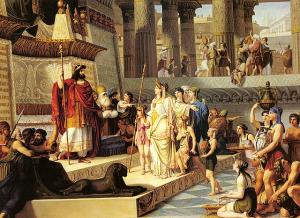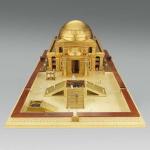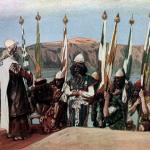1 Kings 10:1-2, 10-11 (RSV) Now when the queen of Sheba heard of the fame of Solomon concerning the name of the LORD, she came to test him with hard questions. She came to Jerusalem with a very great retinue, with camels bearing spices, and very much gold, and precious stones . . . Then she gave the king a hundred and twenty talents of gold, and a very great quantity of spices, and precious stones; never again came such an abundance of spices as these which the queen of Sheba gave to King Solomon. Moreover the fleet of Hiram, which brought gold from Ophir, brought from Ophir a very great amount of almug wood and precious stones.
The Hebrew Sheba is understood by all to be the equivalent of Saba“: a kingdom (the Sabaeans or Sabeans) in the southwest of the Arabian peninsula (current-day Yemen). Joel 3:8 refers to “the Sabeans, . . . a nation far off.” Isaiah 45:14 also makes mention of “the Sabeans,” as does Job 1:15, while Job 6:19 has “the travelers of Sheba” and Psalm 72:10, “the kings of Sheba” (cf. Ezek. 38:13). They were exporters of gold (Ps. 72:15: “gold of Sheba”; Isa. 60:6: “those from Sheba . . . shall bring gold and frankincense”), as well as of precious stones and spices (Ezek. 37:22: “The traders of Sheba . . . traded with you; they exchanged for your wares the best of all kinds of spices, and all precious stones, and gold”), and incenses and perfumes (Jer. 6:20: “frankincense . . . from Sheba”). Jesus assumes her historicity as well as Solomon’s:
Matthew 12:42 The queen of the South will arise at the judgment with this generation and condemn it; for she came from the ends of the earth to hear the wisdom of Solomon, and behold, something greater than Solomon is here. (cf. Lk 11:31; almost identical language)
Sheba is mentioned in conjunction with four other peoples and trading and commerce in Isaiah 60:6-7. Midian was located in northwestern Arabia. Ephah is also believed to be Arabian, and may have been near present-day Median (Yathrib in ancient times). Kedar, or the Qedarites, attested since the 8th century B.C., were located in northern Arabia, as were the people of Nebaioth, descendants of the Ishmaelites. These were likely associated with Sheba in the Bible because of their being on the incense trade route, which flourished on the western and southern coasts of Arabian peninsula, by the Red Sea and Indian Ocean.
Egyptologist and archaeologist Kenneth Kitchen provides the basic background:
In the late eighth and early seventh centuries we have Assyrian mentions of Itamru (Yithas’amar) and Karibilu (Karibil) as kings of Saba . . . Before that, Assyrian sources record Sabaean trade caravans explicitly for the later eighth and implicitly for the early ninth centuries, little more than half a century after Solomon [r. c. 970-c. 931 B.C.]. As they traveled freely north, so could she have done. (1)
Does trade from Sheba date to the Queen of Sheba or even further back, according to secular science? One historian offers near-proof:
In the ancient period, it would seem that South Arabia and the Horn of Africa were the major suppliers of incense, . . . Early ritual texts from Egypt show that incense was being brought to the upper Nile by land traders, but perhaps the most spectacular evidence of this trade is provided by the frescos dated to around 1500 BC on the walls of the temple at Thebes commemorating the journey of a fleet that the Queen of Egypt had sent to the Land of Punt. Five ships are depicted in these reliefs, piled high with treasure, and one of them shows thirty-one small incense trees in tubs being carried on board. (2)
The “Land of Punt” is generally agreed to be in eastern Africa: modern-day Somalia and/or Ethiopia: directly across from ancient Sheba in present-day Yemen. If Egyptian ships could make it to Punt via the Red Sea, they could just as easily stop by Sheba on the other side of the water. And the queen of Sheba could have (and probably did) travel mostly by water, with a relatively short land journey to get to Jerusalem.
Keall uncovered zoomorphic and anthropomorphic figurines from the site of al-Midammam on the Red Sea in ancient Sheba, dated to between c. 2500 B.C. and the tenth century B.C. (3) Gunnar Sperveslage (4) summarizes an abundance of research findings that establish a date of trade between ancient Yemen and Egypt to some dozen centuries before Solomon and Sheba:
At the end of the 2nd millennium BCE [1000 B.C.] the camel was domesticated on the Arabian Peninsula . . . (5) (6) and it replaced the donkey as a pack animal on long distance trade routes. The ability of the camel to get along without water for days increased the efficiency of trade in desert regions. Although watering holes and wells occur frequently, only the large oases, which are not less than a few days’ ride apart, were capable of supplying large caravans with enough water. The overland trade of aromatics, and especially of frankincense, was the most important source of revenue for South Arabia, resulting in prosperity and wealth. . . . not long after the domestication of the camel, the ancient South Arabian Kingdom of Saba arose as an ancient civilisation of high culture. (p. 305)*According to recent archaeological fieldwork, the time span of intercultural contacts can be projected back at least as far as the late Old Kingdom. [which ended c. 2200 B.C.] . . . The Italo-American excavations at Mersa Gawasis on the Egyptian Red Sea coast exposed detailed information on the ancient harbour site and its use from the late Old Kingdom to the early New Kingdom (7) (8) . . . Ship timbers and naval equipment, such as blades of steering oars, ropes, anchors and cargo boxes have been found, as well as some fragments of exotic pottery, indicating the wide network of naval activities around 2000 BCE. A few pottery sherds occurred that originated from the Yemeni Tihama and the Aden region. They were found in assemblages dating from the late Old to the late Middle Kingdom [which ended in 1782 B.C.] (9) (10) . . . the presence of South Arabian pottery in Middle Kingdom Egypt illustrates beyond doubt aspects of long distance trade and exchange of goods conducted by people from ancient Yemen long before the rise of the Sabaean Kingdom. (p. 308)
A very recent discovery is even more directly relevant to the question of Solomon and Sheba. Daniel Vainstub, of Ben-Gurion University of the Negev, summarizes:
In Eilat Mazar’s excavations in the Ophel in Jerusalem, a partially preserved inscription engraved on the shoulder of a pithos was found in 2012 in a context dated to the 10th century BCE. . . . In this study, it is argued that the inscription was engraved in the Ancient South Arabian script and that its language is Sabaean. The inscription reads “ ]šy ladanum 5.” The aromatic ladanum (Cistus ladaniferus),. . . [is] the second component of incense according to Exod 30:34. The inscription was engraved before the locally made vessel was fired, leading to the conclusion that a Sabaean functionary entrusted with aromatic components of incense was active in Jerusalem by the time of King Solomon. (11)
FOOTNOTES
1) Kenneth A. Kitchen, On the Reliability of the Old Testament (Grand Rapids, Michigan: Wm. B. Eerdmans Publishing Co., 2003), 116.
2) Himanshu Prabha Ray, The Archaeology of Seafaring in Ancient South Asia (Cambridge University Press: 2003), 31.
3) E. Keall, “Possible connections in antiquity between the Red Sea coast of Yemen and the Horn of Africa,” in P. Lunde, A. Porter (eds), Trade and travel in the Red Sea region (Oxford: 2004), 45, figures 11-12.
4) Gunnar Sperveslage, “Intercultural contacts between Egypt and the Arabian Peninsula at the turn of the 2nd to the 1st millennium BCE,” ch. 14 (pp. 303-330), in J. C. Moreno García (ed.): Dynamics of Production in the Ancient Near East 1300-500 BC (Oxford: 2016). (Link)
5) See H.-P Uerpmann & M. Uerpmann, “The appearance of the domestic camel in south-east Arabia,” Journal of Oman Studies 12 (2002): 235–260.
6) See M. Heide, “The domestication of the camel: biological, archaeological and inscriptional evidence from Mesopotamia, Egypt, Israel and Arabia, and traditional evidence from the Hebrew Bible,” Ugarit-Forschungen 42 (2010): 331–382.
7) K. A. Bard & R. Fattovich (eds), Harbor of the Pharaohs to the Land of Punt. Archaeological Investigations at Mersa/Wadi Gawasis, Egypt, 2001–2005 (Naples: 2007).
8) K. A. Bard, R. Fattovich, & C. Ward, “Sea Port to Punt: new evidence from Mersā Gawāsīs, Red Sea (Egypt),” in J. Starkey, P. Starkey & T. Wilkinson (eds), Natural Resources and Cultural Connections of the Red Sea (British Archaeological Report S1661 /Society for Arabian Studies Monographs 5), 143–148, (Oxford: 2007).
9) Bard & Fattovich, 130–131.
10) Bard, Fattovich, & Ward, 147.
11) Daniel Vainstub, “Incense from Sheba for the Jerusalem Temple,” Jerusalem Journal of Archaeology (Jan. 2023) 4: 42–68. (Link)
12) Vainstub, 45-46.
13) See M.B. Piotrovskij and A. V. Sedov, “Field-Studies in Southern Arabia,” Ancient Civilizations from Scythia to Siberia (1994) 1: 202–219; particularly pp. 204-206; A. Avanzini, Corpus of South Arabian Inscriptions I–III: Qatabanic, Marginal Qatabanic, Awsaniete Inscriptions (Pisa: Edizioni Plus—Università di Pisa, 2004), 10.
See Related Articles
Archaeology & Solomon’s Temple-Period Ivory [1-28-23]
King Solomon’s “Mines” & Archaeological Evidence [3-24-23]
Solomon’s “Impossible” (?) Wealth & Archaeology [4-25-23]
Solomon’s Temple and its Archaeological Analogies (Also, Parallels to Solomon’s Palace) [4-25-23]
***
Practical Matters: Perhaps some of my 4,200+ free online articles (the most comprehensive “one-stop” Catholic apologetics site) or fifty-one books have helped you (by God’s grace) to decide to become Catholic or to return to the Church, or better understand some doctrines and why we believe them.
Or you may believe my work is worthy to support for the purpose of apologetics and evangelism in general. If so, please seriously consider a much-needed financial contribution. I’m always in need of more funds: especially monthly support. “The laborer is worthy of his wages” (1 Tim 5:18, NKJV). 1 December 2021 was my 20th anniversary as a full-time Catholic apologist, and February 2022 marked the 25th anniversary of my blog.
PayPal donations are the easiest: just send to my email address: [email protected]. You’ll see the term “Catholic Used Book Service”, which is my old side-business. To learn about the different methods of contributing, including 100% tax deduction, etc., see my page: About Catholic Apologist Dave Armstrong / Donation Information. Thanks a million from the bottom of my heart!
***
Photo credit: Solomon And The Queen Of Sheba, by Giovanni Demin (1789-1859) [public domain / Wikimedia Commons]
***
Summary: Is the queen of Sheba and her famous visit to see king Solomon the stuff of myth and legend or actual history? I provide significant evidence in favor of the latter.














